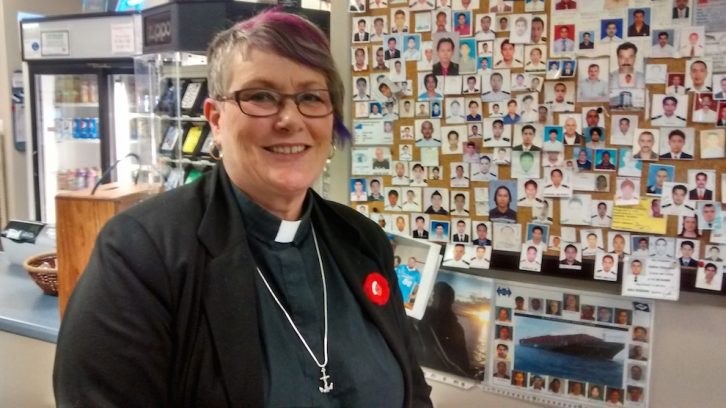Shipping
Mission to Seafarers helps sailors in need
"Dutch Runner" labour dispute one of many problems local charity deals with

caption
Rev. Maggie Whittingham Lamont with photos of sailors who have visited the Mission over the years.
caption
Rev. Maggie Whittingham Lamont with photos of sailors who have visited the Mission over the years.When the crew of the cargo vessel Dutch Runner said their wages had not been paid and food was running low on board, the Mission to Seafarers stepped in to help.
“Seafarers are an often marginalized and isolated group,” says Karl Risser, a representative of the International Transport Workers’ Federation (ITW), adding that this makes it easy for them to be exploited.
By Monday, the crew was paid and the ship headed for its home port.
This is partly due to Rev. Maggie Whittingham Lamont, chaplain of the Mission to Seafarers, who helped the ITW negotiate with the ship’s owners.
Lamont describes the Mission as “a non-profit organization that provides for the spiritual, moral and physical welfare of seafarers.”
This month, the volunteers and staff, which includes Lamont and manager Helen Glenn, are busy with what they call the Shoebox Campaign. Every year, they prepare hundreds of wrapped Christmas boxes for seafarers. Each box contains a hat, scarf, gloves, socks, toothbrush, razor, soap, shampoo, deodorant, and a small souvenir of Canada. According to their website, in 2015 they gave out 1,600 boxes.
“To us these aren’t luxuries, but to these guys, they’re luxuries,” says Lamont, adding that these basic items are “not necessarily” provided on a ship.
The Mission houses a roomful of secondhand clothes and books, a lounge with a TV and phone and Internet booths so that the seafarers can relax while off duty and stay in touch with family members. Lamont says the biggest problem they face is loneliness.
“Sometimes they’re the only one of their ethnicity on board, they don’t speak the language (and) they can’t eat their ethnic food,” she says. “Typically they go nine to 10 months without seeing their home.”
The Mission tries to help people from around the world.
“(We) mostly (help) Filipinos, Indians, Eastern Europeans, Chinese, Tanzanians,” says Lamont. “Once I had a cruise ship come through with 59 different nations on board.”
She says racial tension is rare because “they all depend on each other for their safety, with lifeboat drills and things like that,” but isolation still takes its toll.
Another problem is nutrition.
“The food on board isn’t always the freshest or healthiest,” says Lamont.
Despite the good it does, the Mission has its own set of problems.
According to its 2015 financial report from the Canada Revenue Agency, it has a deficit of around $26,000. The previous years show similar figures.
“We’re not sexy,” says Lamont, with a smile and a shrug. “We don’t deal with children or disasters.”
And yet, Lamont says, seafarers are vital to Canada’s economy because so many goods are imported by ships.
“I’m not wearing anything that was made in Canada,” she says, gesturing to the silver anchor-cross necklace she wears.
Lamont and her co-workers finance their operation with an array of fundraisers, such as golf tournaments, wine tastings, a monthly luncheon, annual Christmas meals at the Cunard Centre, applications for grants from the government and direct mail appeals to the public.
“Going to sea, it’s a really tough life,” says Bruno Ortis.
A former fisherman from Mexico, he was living in Halifax’s homeless shelters before the Mission found him a job as a commercial diver. Now he volunteers at the Mission and calls its staff “pretty much [his] family.”
“I have wandered for 10 years and met many people who don’t understand what sacrifices we make,” he says. “But I’ve met people like Reverend Maggie, with good hearts; they’re trying to help every way they can.”

